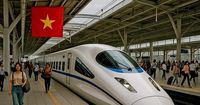On April 17, 2025, the Hòa Phát Group (HoSE: HPG) held its Annual General Meeting of Shareholders in Hanoi, unveiling ambitious plans for the future of the company and the Vietnamese steel industry. The meeting attracted over 1,000 attendees, marking a record turnout for the company, which boasts more than 190,000 shareholders, making it the largest publicly traded enterprise in Vietnam.
During the meeting, Chairman Trần Đình Long reported impressive financial results for the first quarter of 2025, with revenues reaching 37 trillion VND and after-tax profits of 3.3 trillion VND. This performance aligns with the company’s targets for the year, which aim for a total revenue of 170 trillion VND and a profit of 15 trillion VND, representing increases of 22% and 25% compared to 2024.
One of the key highlights of the meeting was the announcement of Hòa Phát's plans to commence construction of a railway and special steel production plant in Dung Quat 2, Quảng Ngãi, in May 2025. This plant, with a total investment of 14 trillion VND, is set to produce high-quality railway steel, with the first products expected to roll out by May 2027. This initiative comes in response to a directive from the government, which has tasked Hòa Phát with supplying all steel materials for several major railway projects across the country, including the North-South high-speed railway and the TP. HCM - Cần Giờ line.
Long reassured shareholders concerned about the market demand for railway steel, stating, "Just last week, the Ministry of Construction presented a draft decree to the government to assign specific orders to domestic enterprises. Therefore, we can be completely assured about the output of Hòa Phát's railway steel segment." This marks a significant moment as it is the first time a private enterprise in Vietnam has received such strong support from the government, setting a solid foundation for Hòa Phát's future growth.
Hòa Phát estimates that it can supply around 10 million tons of steel for railway lines. However, Long noted that this figure could increase as new projects are continuously proposed. In addition to railway steel, Hòa Phát is also collaborating with major automotive manufacturers like VinFast, THACO, and Thành Công to supply raw materials and steel for train and locomotive manufacturing.
Moreover, the company is expanding its operations with the completion of the first phase of the Dung Quat 2 project, which began in 2022. This phase has produced initial products and is part of a larger project with a total investment of 85 trillion VND, covering 280 hectares and designed to produce 5.6 million tons of hot-rolled coil (HRC) steel annually. Hòa Phát plans to fully operationalize the project this year, increasing its total capacity to 15 million tons per year.
In light of recent global trade tensions, Hòa Phát is also navigating a challenging landscape, with rising protectionist measures affecting steel imports into key markets like the U.S., Japan, and the EU. The U.S. has imposed a 25% tariff on imported steel, and the Department of Commerce has announced a preliminary anti-dumping tax of 49.42% on Hòa Phát's coated steel products. However, the domestic market is presenting new opportunities as the Ministry of Industry and Trade has decided to impose anti-dumping tariffs on hot-rolled steel and coated steel originating from China, a move that is expected to help Hòa Phát increase its domestic market share.
In addition to the Dung Quat 2 project, Hòa Phát announced plans for a new large-scale steel project in Phú Yên, with a total investment of 86 trillion VND and a designed capacity of 6 million tons per year. This project is expected to be completed within three years and is seen as a pivotal part of the company's expansion strategy.
Looking ahead, Hòa Phát is positioning itself to participate in major national infrastructure projects, particularly the high-speed railway initiative, which is projected to require over 100 billion USD in investments over the next decade. The pressing question remains: Is Hòa Phát prepared and capable of securing a significant role in this monumental infrastructure endeavor?
As the steel industry grapples with both domestic and international challenges, Hòa Phát's proactive approach and government support could be crucial in navigating the complexities of the market. With ambitious production goals and a clear strategy for collaboration with key industries, the company is poised to play a vital role in shaping the future of Vietnam's infrastructure and industrial landscape.





